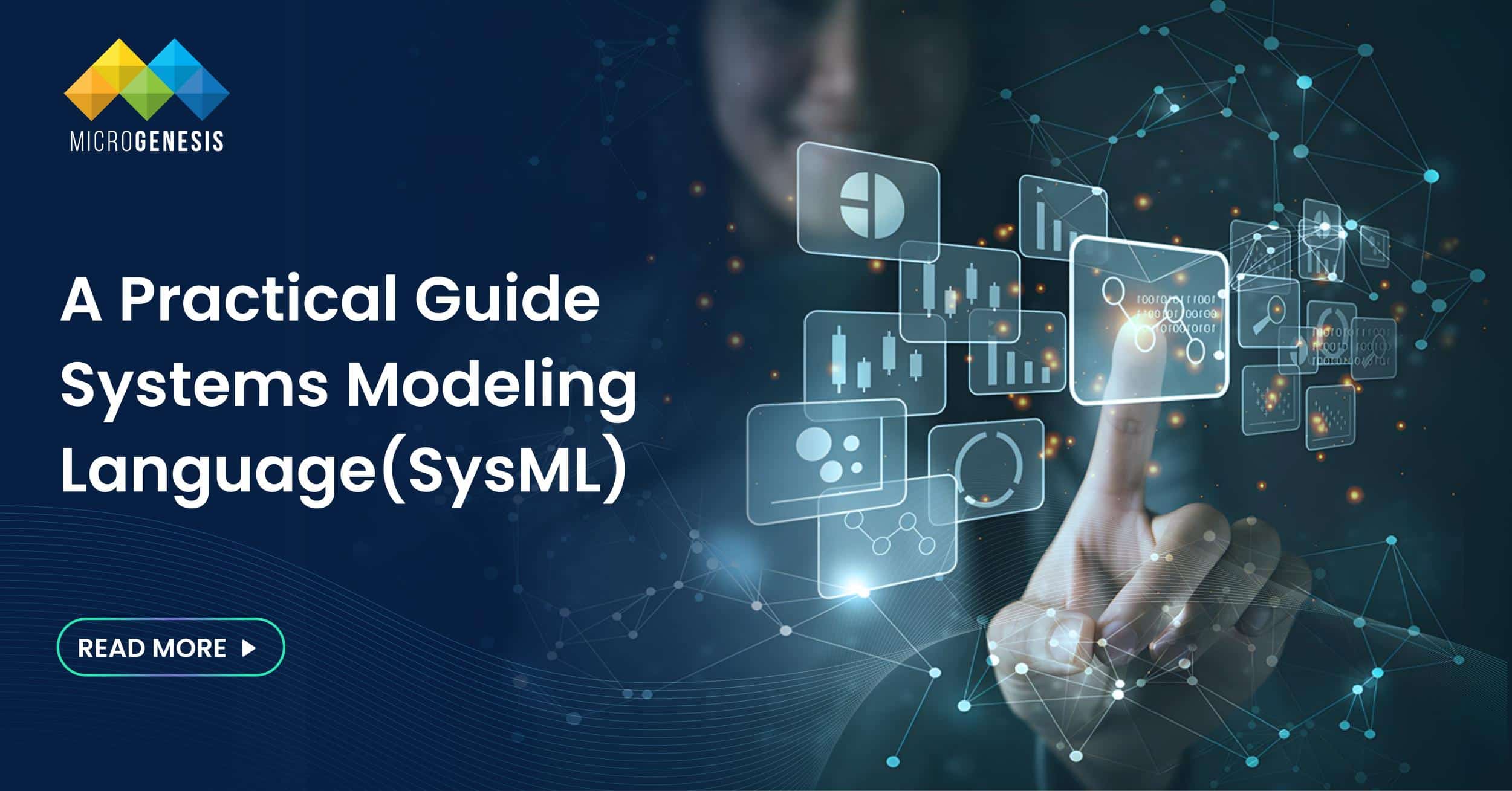The Systems Modeling Language (SysML) is a powerful modeling language designed to support the design, development, and deployment of complex systems. Initially an extension of the Unified Modeling Language (UML), SysML provides a structured approach to Model-Based Systems Engineering (MBSE) and has evolved significantly since its first version.
Key Features of SysML:
- Modeling Flexibility: SysML accommodates both logical and physical representations of systems.
- Enhanced Communication: It bridges the communication gap between interdisciplinary teams by offering consistent, precise, and detailed system representations.
- Scalability: SysML supports both high-level and detailed system designs, making it ideal for complex, multi-layered systems.
Benefits of SysML in Model-Based Systems Engineering (MBSE)
Model-Based Systems Engineering (MBSE) improves the flow of information through the use of a system model, allowing greater accuracy, consistency, and collaboration across teams.
Advantages of SysML in MBSE:
- Reduction in Errors: A model-based approach reduces ambiguities inherent in traditional documentation, minimizing errors in system design.
- Improved Collaboration: SysML helps in aligning cross-functional teams, providing a common language to describe systems in various stages of development.
- Traceability: SysML allows for clear traceability between system requirements, design, and implementation, ensuring that all elements are properly connected and verified.
- Cost & Time Efficiency: With fewer design iterations, errors, and communication gaps, SysML helps reduce overall development time and costs.
Key Diagrams in SysML
SysML provides various diagram types to represent system behavior, structure, and requirements. Each diagram serves a different purpose in system modeling.
1. Requirements Diagrams:
- Purpose: To capture and manage system requirements.
- Features:
- Defines system scope and key stakeholders.
- Links system requirements to design elements for validation.
- Tracks dependencies between various requirements.
2. Structure Diagrams:
- Purpose: To visualize the physical and logical components of the system.
- Features:
- Block Definition Diagrams (BDD): Shows the relationships between system blocks, controls, and interfaces.
- Internal Block Diagrams (IBD): Provides a view of the internal parts of system components and their interactions.
- Package Diagrams: Highlights the relationships between packages, models, views, and dependencies.
- Parametric Diagrams: Establishes mathematical and performance-based constraints between different system components.
3. Behavior Diagrams:
- Purpose: To model the dynamic behavior of the system.
- Features:
- Activity Diagrams: Describes the flow of actions and events within the system.
- State Machine Diagrams: Represents state transitions of system components in response to events.
- Sequence Diagrams: Illustrates interactions and message flows between different system elements.
- Use Case Diagrams: Defines how users and external systems interact with the system.
SysML vs. UML: A Comparison
While SysML was initially an extension of UML (Unified Modeling Language), it has evolved to cater to the specific needs of systems engineers.
Key Differences:
- Domain Focus: UML focuses on software design, while SysML is more aligned with systems engineering, especially in multi-disciplinary projects.
- Diagram Variety: SysML incorporates diagrams for physical system modeling, which are absent in UML.
- Complexity Handling: SysML is better suited for large, complex systems with multiple interacting components, whereas UML is more software-centric.
Why SysML Was Needed:
- Extended Capabilities: UML’s limited focus on software systems led to the development of SysML to address the needs of complex, multi-disciplinary system development, such as in aerospace and automotive industries.
SysML v1 vs. SysML v2: Evolution of the Language
SysML v2 builds on the foundational elements of SysML v1 but introduces more powerful tools and integrations to address the growing complexity of systems development.
Key Features of SysML v2:
- Introduction of KerML: A kernel modeling language that defines syntax and semantics, enhancing interoperability between tools.
- New API for Automation: SysML v2 introduces an Application Programming Interface (API) to facilitate automation and easier integration with other software tools.
- Improved Precision & Expressiveness: SysML v2 addresses limitations of v1 by providing more detailed system descriptions and handling complex hierarchies of structures and behaviors.
- Extended Diagrams: SysML v2 expands from 9 to 14 diagrams, offering additional tools to model and represent complex systems more effectively.
Key Role of Kernel Modeling Language (KerML)
SysML v2’s reliance on KerML provides a robust backbone for ensuring that the language can evolve and interact seamlessly with other modeling standards and tools.
Benefits of KerML Integration:
- Consistent Semantics: KerML offers a unified framework to define system modeling terms and relationships.
- Improved Tool Integration: The framework allows better interoperability between SysML models and other engineering tools used for requirements management, testing, and product lifecycle management.
- Customizability: KerML allows developers to tailor SysML to fit domain-specific needs by defining extensions.
Real-world Applications of SysML
SysML is widely used across industries where complex systems need to be modeled and managed. The industries benefiting most from SysML include:
1. Aerospace & Defense:
- SysML helps manage the intricacies of aerospace systems by providing clear traceability of system requirements and design elements. It’s vital for ensuring safety and regulatory compliance in mission-critical systems.
2. Automotive:
- In the automotive sector, SysML supports the development of software-defined vehicles, enabling better management of electronic systems, control software, and complex supply chains.
3. Medical Devices:
- SysML allows for efficient systems engineering in the medical devices industry, ensuring compliance with regulatory standards, improved device safety, and more streamlined testing processes.
SysML’s Role in Digital Thread and Digital Twin Initiatives
In complex systems engineering, SysML supports the integration of Digital Thread and Digital Twin concepts.
Digital Thread:
- SysML allows for the creation of a continuous thread of data through the system’s lifecycle, from design through manufacturing, maintenance, and decommissioning.
Digital Twin:
- SysML models can be used to develop digital representations (twins) of physical systems, allowing for real-time monitoring, simulation, and optimization of systems during their operational phase.
SysML Tools and Ecosystem
A wide array of tools supports SysML, enabling teams to integrate the language into their existing development and lifecycle processes.
Popular SysML Tools:
- Cameo Systems Modeler
- MagicDraw
- Enterprise Architect
- Rhapsody
- Sparx Systems
Tool Ecosystem:
- SysML tools are designed to interact with other essential engineering tools, including requirements management tools, simulation platforms, and testing frameworks. The new API in SysML v2 enhances this interoperability.
The Future of SysML
SysML is expected to evolve further, with new extensions planned to address emerging technologies and industries.
Key Trends Shaping SysML’s Future:
- Modular Extensions: SysML will become even more modular, allowing disciplines to create new extensions tailored to specific needs (e.g., aerospace or healthcare).
- KerML’s Influence on UML: A possible future successor to UML may be based on KerML, allowing for seamless integration between software and systems models.
- Broader Adoption in Digital Engineering: SysML will continue to play a critical role in digital engineering initiatives across industries, driving more efficient and accurate system designs.
Conclusion
SysML is a key enabler of Model-Based Systems Engineering (MBSE), offering teams the tools they need to manage the design and lifecycle of complex systems. With its wide range of diagrams, advanced features in SysML v2, and integration with KerML, SysML provides a powerful framework for managing today’s increasingly intricate systems.
At MicroGenesis, a Digital Transformation Company, we leverage SysML and other cutting-edge tools to help organizations adopt MBSE practices seamlessly. Our expertise in systems engineering ensures that your product development process is streamlined, efficient, and aligned with industry best practices, driving innovation and long-term success. MicroGenesis is also a trusted partner with PTC for Codebeamer ALM, offering comprehensive solutions to manage complex product lifecycles. With over 16 years of successful collaboration with IBM, we specialize in implementing IBM ELM solutions, ensuring integrated, end-to-end engineering lifecycle management.




